
A ball is a round object with several uses. It is used in ball games, where the play of the game follows the state of the ball as it is hit, kicked or thrown by players. Balls can also be used for simpler activities, such as catch or juggling. Balls made from hard-wearing materials are used in engineering applications to provide very low friction bearings, known as ball bearings. Black-powder weapons use stone and metal balls as projectiles.
Hockey is a term used to denote a family of various types of both summer and winter team sports which originated on either an outdoor field, sheet of ice, or dry floor such as in a gymnasium. While these sports vary in specific rules, numbers of players, apparel, and playing surface, they share broad characteristics of two opposing teams using sticks to propel a ball or disk into a goal.
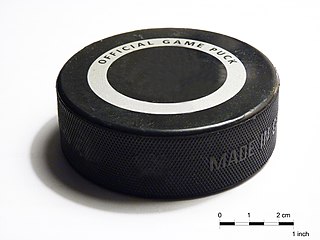
A hockey puck is either an open or closed disk used in a variety of sports and games. There are designs made for use on an ice surface, such as in ice hockey, and others for the different variants of floor hockey which includes the wheeled skate variant of inline hockey. They are all designed to serve the same function a ball does in ball games.
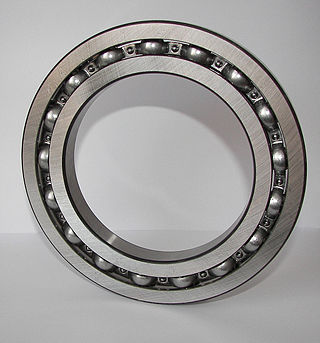
A bearing is a machine element that constrains relative motion to only the desired motion and reduces friction between moving parts. The design of the bearing may, for example, provide for free linear movement of the moving part or for free rotation around a fixed axis; or, it may prevent a motion by controlling the vectors of normal forces that bear on the moving parts. Most bearings facilitate the desired motion by minimizing friction. Bearings are classified broadly according to the type of operation, the motions allowed, or the directions of the loads (forces) applied to the parts.

In mechanical engineering, a rolling-element bearing, also known as a rolling bearing, is a bearing which carries a load by placing rolling elements between two concentric, grooved rings called races. The relative motion of the races causes the rolling elements to roll with very little rolling resistance and with little sliding.

A marble is a small spherical object often made from glass, clay, steel, plastic, or agate. They vary in size, and most commonly are about 13 mm in diameter. These toys can be used for a variety of games called marbles, as well being placed in marble runs or races, or created as a form of art. They are often collected, both for nostalgia and for their aesthetic colors.
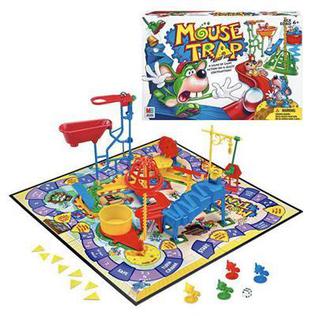
Mouse Trap is a board game first published by Ideal in 1963 for two to four players. It is one of the first mass-produced three-dimensional board games. Players at first cooperate to build a working mouse trap in the style of a Rube Goldberg machine. Then, players turn against each other to trap opponents' mouse-shaped game pieces.

In computer graphics, a sprite is a two-dimensional bitmap that is integrated into a larger scene, most often in a 2D video game. Originally, the term sprite referred to fixed-sized objects composited together, by hardware, with a background. Use of the term has since become more general.

Floor hockey is a broad term for several indoor floor game codes which involve two teams using a stick and type of ball or disk. Disks are either open or closed but both designs are usually referred to as "pucks". These games are played either on foot or with wheeled skates. Variants typically reflect the style of ice hockey, field hockey, bandy or some other combination of sport. Games are commonly known by various names including cosom hockey, ball hockey, floorball, or simply floor hockey.

A thrust bearing is a particular type of rotary bearing. Like other bearings they permanently rotate between parts, but they are designed to support a predominantly axial load.

Inline hockey or roller hockey is a variant of hockey played on a hard, smooth surface, with players using inline skates to move and ice hockey sticks to shoot a hard, plastic puck into their opponent's goal to score points. The sport is a very fast-paced and free-flowing game and is considered a contact sport, but body checking is prohibited. There are five players including the goalkeeper from each team on the rink at a time, while teams normally consist of 16 players. There are professional leagues, one of which is the National Roller Hockey League (NRHL). While it is not a contact sport, there are exceptions, i.e. the NRHL involves fighting.
A linear-motion bearing or linear slide is a bearing designed to provide free motion in one direction. There are many different types of linear motion bearings.
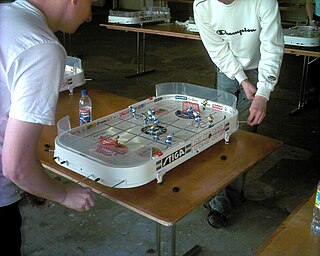
A table hockey game, also called rod hockey game, stick hockey, bubble hockey, and board hockey, is a game for two players, derived from ice hockey. The game consists of a representation of a hockey rink; the players score goals by hitting a small puck into the opposing "net" with cutout figures that represent hockey players. The figures are manipulated by rods below the "ice": each one slides forward and back along its own narrow slot when the player pushes or pulls on the rod, or rotates to shoot or stickhandle the puck when the player spins the rod. Though similar in concept to air hockey, table hockey games are more of a simulation of the sport of ice hockey while air hockey is more abstract.

A drawer is a box-shaped container inside a piece of furniture that can be pulled out horizontally to access its contents. Drawers are built into numerous types of furniture, including cabinets, chests of drawers (bureaus), desks, and the like.
Super Monkey Ball is a series of arcade platform video games initially developed by Amusement Vision and published by Sega. The series debuted in 2001 with the arcade game Monkey Ball, which was ported to GameCube as Super Monkey Ball later that year. Several sequels and ports have been released.
A fingerboard is a scaled-down replica of a skateboard that a person "rides" with their fingers, rather than their feet. A fingerboard is typically 100 millimeters (3.9 in) long with width ranging from 26 to 55 mm, with graphics, trucks and plastic or ball-bearing wheels, like a skateboard. A fingerboard can be used to do traditional skateboarding tricks, such as an ollie and kickflip.

Virtuality was a range of virtual reality machines produced by Virtuality Group, and found in video arcades in the early 1990s. The machines delivered real-time VR gaming via a stereoscopic VR headset, joysticks, tracking devices and networked units for a multi-player experience.
Sente Technologies was an arcade game company. Founded as Videa in 1982 by ex-Atari employees Roger Hector, Wendi Allen, and Ed Rotberg, the company was bought by Nolan Bushnell and made a division of his Pizza Time Theatre company in 1983. In 1984 the division was acquired by Bally Midway who continued to operate it until closing it down in 1988. The name Sente, like Atari, is another reference to Bushnell's favorite game, Go and means "having the initiative."
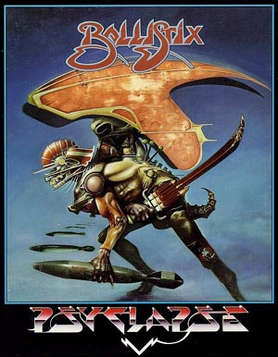
Ballistix is a video game created by Martin Edmondson for the Amiga and Atari ST and published by Psyclapse in 1989. It was also converted to a number of other home computers in the same year and the PC Engine/TurboGrafx-16 console in 1991. It is a fictional futuristic sport involving directing a puck to a goal by shooting small balls at it.














